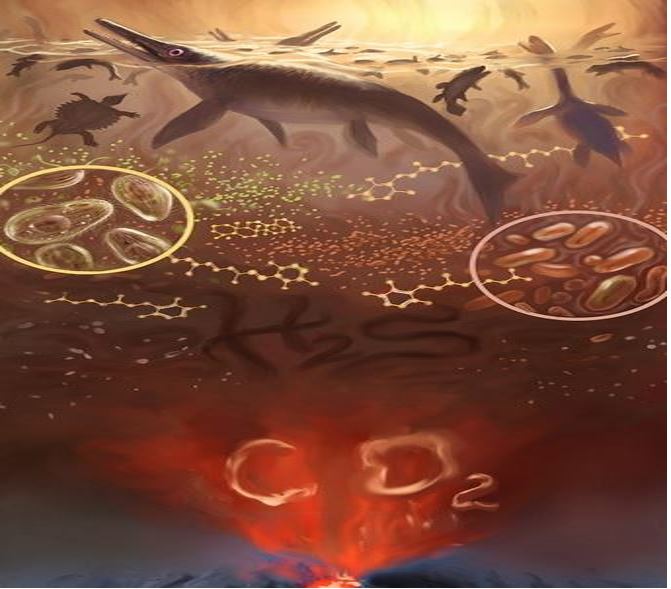Two hundred million years ago, half of all plant, animal and marine life became extinct, and evidence shows that oxygen-depleted toxic oceans played a key role, researchers from the US, UK, Australia and Canada reported this week.
The scientists’ findings, which have been published in the academic journal Geology (citation below), show that a condition called ‘marine photic zone euxinia’ occurred in the Panathalassic Ocean, the larger of the two oceans that surrounded Pangaea, the supercontinent.
Photic zone euxinia occurs when the surface of the ocean, the part that is lit by sunlight, lacks oxygen and becomes poisoned with hydrogen sulphide (US spelling: sulfide). When microorganisms live without oxygen, hydrogen sulphide is one of their by-products, a substance that is extremely toxic for most other lifeforms.

Life of the Triassic met a toxic and choking end in a runaway greenhouse climate, heating the seas into warm stagnation. (Image credit: Victor Leshyk)
The scientific team studied fossilised organic molecules taken from sedimentary rocks that had originally built up on the bottom of the north-eastern Panthalassic Ocean, which today are exposed on the Queen Charlotte Islands, off the British Columbian coast.
They found molecules derived from photosynthesizing brown-pigmented green sulphur bacteria, microorganisms that can only exist in environments severely devoid of oxygen. Their finding proved that in the upper ocean 201 million years ago, oxygen levels were extremely low and hydrogen sulphide levels were toxic.
They also found there had been significant changes in the nitrogen composition of organic matter, suggesting that disruptions in marine nutrient cycles occurred at the same time as the development of low oxygen conditions.
Changes occurred globally
Previous studies have found evidence of photic zone euxinia on land and shallow, near-shore environments during this period. This study, however, is the first to provide compelling evidence from an open ocean setting, indicating that these changes probably occurred across the whole planet.
Co-author, Professor Jessica Whiteside, who works at the University of Southampton’s Ocean and Earth Science, National Oceanography Centre in England, said:
“As tectonic plates shifted to break up Pangaea, huge volcanic rifts would have spewed carbon dioxide into the atmosphere, leading to rising temperatures from the greenhouse effect. The rapid rises in CO2 would have triggered changes in ocean circulation, acidification and deoxygenation.”
“These changes have the potential to disrupt nutrient cycles and alter food chains essential for the survival of marine ecosystems. Our data now provides direct evidence that anoxic, and ultimately euxinic, conditions severely affected food chains.”
“The same CO2 rise that led to the oxygen depleted oceans also led to a mass extinction on land, and ultimately to the ecological take-over by dinosaurs, although the mechanisms are still under study.”
Eerie similarity to current fossil-fuel burning
While the Earth was considerably different 201 million years ago compared to today, the rates of CO2 release from volcanic rifts were not that different from what is occurring today as a result of the burning of fossil fuels.
Prof. Whiteside added: “The release of CO2 was probably at least as rapid as that caused by the burning of fossil fuels today, although the initial concentrations were much higher in the Triassic. The consequences of rapidly rising CO2 in ancient times inform us of the possible consequences of our own carbon dioxide crisis.”
Citation: “Episodic photic zone euxinia in the northeastern Panthalassic Ocean during the end-Triassic extinction,” Alex H. Kasprak1, Julio Sepúlveda, Rosalyn Price-Waldman, Kenneth H. Williford, Shane D. Schoepfer, James W. Haggart, Peter D. Ward, Roger E. Summons and Jessica H. Whiteside. Geology. First published online February 27, 2015. DOI: 10.1130/G36371.1.
